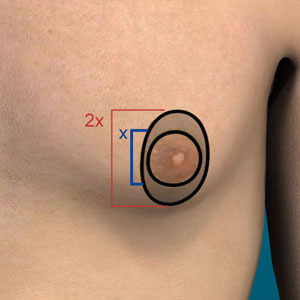Gynecomastia Type 4-Chest Angle 60-90° Moderate Breast Sag
Definition
Chest angle is between 60-90 degrees. Moderate skin sag.
- Overview of Gynecomastia
- Causes of Gynecomastia
- Ideal male chest
- Joseph T Cruise, MD's Gynecomastia Philosophy
- 7 Types of Gynecomastia
- 1-Puffy nipple. Breast tissue outside of areola
- 2-Chest angle less than 45 °
- 3-Chest angle 45-60° Mild breast sag
- 4-Chest angle 60-90° Moderate breast sag
- 5-Chest angle greater than 90° Significant sag
- 6-Top of areola is above chest fold. Severe sag
- 7-Top of areola is below chest fold. Extreme sag
- Are You a Good Candidate?
- Benefits of Male Breast Reduction
- Components of Gynecomastia
- Classic Gynecomastia
- Puffy Nipples
- Fatty Gyecomastia
- Saggy Gynecomastia
- Breast Roll
- Prior to Male Breast Reduction
- Male Breast Reduction Anesthesia
- After the Male Breast Reduction
- Recovery from Male Breast Reduction
- Possible Complications
- Gynecomastia Cost and Financing
- Gynecomastia Words to Know
- Gynecomastia Before and After Pictures
Physical Exam
Type 4 gynecomastia as defined has a Chest Angle of 60-90 degrees(see below). This means that the chest has noticeable sag already. There is already a noticeable component of chest sag. In a Type 4 there is some consideration as to whether or not skin removal is necessary. In Type 4 this is not the case, skin removal is definitely necessary. Otherwise, you will end up with a deflated, saggy chest that arguably looks worse than what you started with.
Gynecomastia Type 4
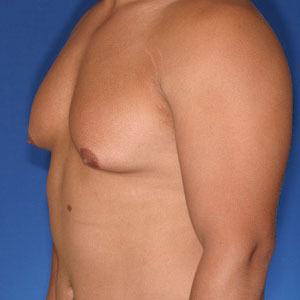
The image below outlines the 7 types of gynecomastia. Types 1 is Puffy Nipple. Types 2-5 are determined by the chest angle. Types 6 and 7 are determined by the position of the nipple in relation to the chest fold.
Gynecomastia Types
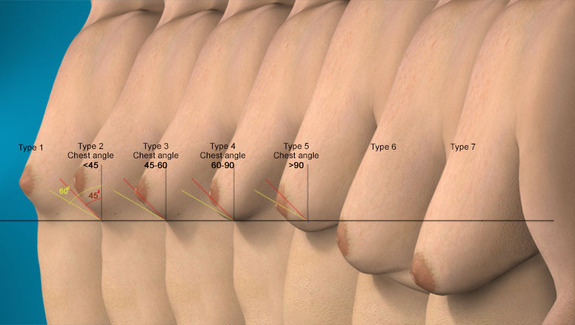
The purpose of categorizing gynecomastia is to determine what type of surgery is necessary to correct a given problem. Joseph T Cruise, MD has developed this classification system based on the extensive work he has done with gynecomastia patients. Other surgeons may use other methods.
Here is how the type of surgery changes depending on the gynecomastia type.
Type 1 - Incision at lower margin of areola
Type 2 - Incision at lower margin of areola
Type 3 - Incision at lower margin of areola or donut lift
Type 4 - Donut lift or anchor lift
Type 5 - Anchor lift
Type 6 - Anchor lift or free nipple graft
Type 7 - Free nipple graft
Here is an enlarged view to show the differences between Types 2-5. The reason why these are grouped together is because the differences are relatively close but they are enough to change the type of surgery necessary to obtain a good result.
Skin laxity differences between types 2-5
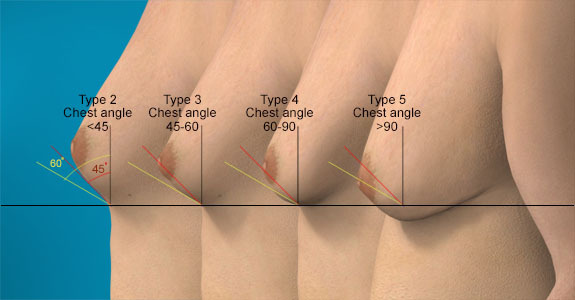
Diagnosing a Type 2,3,4 and 5 gynecomastia. The major difference between the different types is not so much the volume, but rather the skin excess. As you go up, the amount of skin excess increases. This increase in skin excess changes the procedure necessary to correct it. With increasing skin excess, the chest will sag more. This will result in the Chest Fold Angle (CFA) getting smaller and smaller as shown above. Keep in mind, when the breast volume is removed the chest will deflate causing significantly more chest sag. This will further increase the need for skin removal. Failure to address the skin laxity may make the sagginess worse.
- Type 2
- Type 3 45-60 degrees
- Type 4 60-90 degrees
- Type 5 >90 degrees
Surgical implications
- Liposuction
May or may not be useful to remove breast tissue depending on whether or not it is fatty or glandular. If patient is heavy, it may be used to flatten breast roll or decrease fatty deposits at chest margin. - Surgical removal of breast tissue
Surgical removal of breast tissue is often method of choice to ensure that all necessary breast tissue is removed.
Type 4 gynecomastia
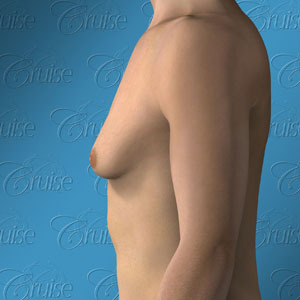
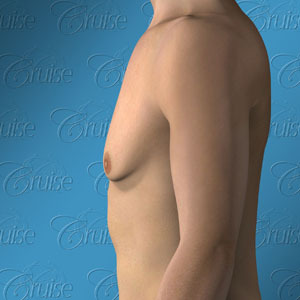
Breast tissue removal only. No skin removal. Notice how the chest deflated and now sags.
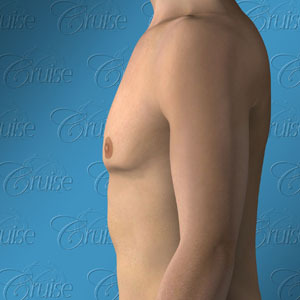
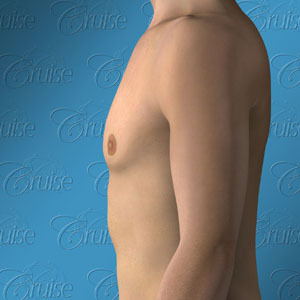
Older male
Breast tissue excision with donut lift. Notice the contour deformity of the bottom of the chest. This is demonstrated below under Preferred Incision. In a younger male with elastic skin a donut lift may be adequate.
Breast tissue removal and anchor lift
Notice how the skin envelop has been tightened.
Notice how the results are highly dependent on the skin quality of the chest. If the skin quality is good then perhaps a donut lift is all that is needed. Otherwise, an anchor lift is necessary in order to predictably obtain a flat chest. Note a donut lift will avoid the longer scars but will likely result in some chest sag. The patient considering the surgery needs to weighs the pros and cons. One caveat; with time the scars become better and better. Whereas, with time the chest sag will get worse. It may only be a small problem for the first few years but it likely will be a significant problem when you are older. Therefore, time is on the side of the anchor lift.
Notice in the "after" with no donut lift have there is considerable chest sag. The volume is removed but the chest simply deflates like a balloon. Compare this to the "after" with donut lift. The skin envelop has been tightened enough to prevent noticeable sag. It is important to understand that the donut lift can only tighten the chest slightly. Trying to remove too much skin with a donut lift will cause rippling and a poor scar. This is why the donut lift is really only useful for Type 3 and some Type 4.
Donut lift limitations
The question with a Type 4 is whether to have a donut lift or go right to an anchor lift. Again, this has a lot to do with skin quality, age, and expectations of the patient. In older people or those with stretch marks over their chest an anchor lift likely will be the best choice. In younger people a donut lift may be considered if there is not too much skin laxity. If there is a breast roll then we are actually dealing with a Type 5 and this requires an anchor lift to correct. A simplistic way of determining whether or not a donut lift will suffice is to draw a donut lift circle around the areola. The upper excision should be 1/3 the diameter of the areola and the lower excision should be 2/3 the diameter of the areola. This is important because it is best not to remove more than 1 areola diameter. Removing more than 1 diameter may result in a poor scar. Now, imitate the donut lift excision by cinching the outer circle down to the size of the inner circle. If this provides an acceptable look you can consider a donut lift. If not, than you should go right to the anchor lift which will allow for a flatter look. Keep in mind, when the breast tissue is removed there will be even MORE breast sag because removing the volume will deflate the chest.
Preferred incision for Type 4
Type 1 - Incision at lower margin of areola
Type 2 - Incision at lower margin of areola
Type 3 - Incision at lower margin of areola or donut lift
Type 4 - Donut lift or anchor lift
Type 5 - Anchor lift
Type 6 - Anchor lift or free nipple graft
Type 7 - Free nipple graft
Type 4 gynecomastia - Donut lift vs anchor lift
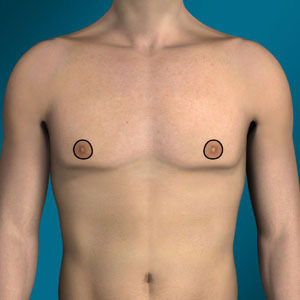
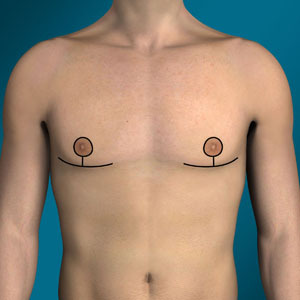
Notice how the donut lift does a good job of tightening the skin below the areola but does not tighten the skin on either side. This may create a flattened contour irregularity as shown above.
Allows for a tighter skin envelop and flatter chest but comes at the expense of a longer incision.

